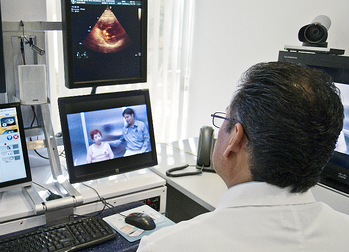 PATTY MURPHY
PATTY MURPHY
HNI Health Systems Consultant
This year's flu strain has been particularly nasty — so nasty, in fact, that it's caused some employees to miss so much work that they could qualify for short-term disability benefits.
This unfortunately has been the reality for some older workers and workers with chronic medical conditions, such as asthma, diabetes, lung or heart disease, or morbid obesity. Other high-risk employees who have had the worst cases of the flu include people who work in health care, nursing homes, or child care.
We recently walked a client through a short-term disability case that revolved around this wicked strain of influenza, and I think the situation points to an emerging trend in health care — using a telemedicine service.
Employee Gets Message: 'Don't Go to Work Sick'
Here's what happened: The client's employee was sick with symptoms of the flu. The employee listened to his employer's advice to stay home and use PTO/sick days to avoid spreading the flu to co-workers.
What's more, the employee saw a news report on how health care providers were discouraging people with minor flu symptoms from visiting the doctor's office and emergency room to prevent spreading the illness.
The sick employee got the message: Stay home and keep the flu to yourself!
For Sick Worker, There's Lots of Lost Time at Work
This is where the story gets interesting.
After 12 days, the sick employee's symptoms were even worse. He called his doctor, who referred him to the emergency room.
Six hours in the ER and one $1,500 bill later, the sick employee was prescribed an influenza anti-viral drug and was sent home for another 5-7 days of rest.
In total, the employee missed three weeks of work. That's a lot of income to forfeit, and that's exactly why some employers offer a short-term disability benefit to their employees.
There's no common definition (federal or state) for short-term disability leave; it depends on the carrier and employer. And the criteria for activating short-term disability leave vary, too.
For the sick employee to get short-term disability, he needed to start by getting documentation from a doctor of his flu. This documentation didn't start until the ER visit.
Most short-term disability policies have an eight-day illness elimination period. In this case, the sick employee was not eligible for a disability benefit until the fourth week, when he actually returned to work.
By trying to keep the flu away from his co-workers, the sick employee ended up:
- Getting worse by not getting care earlier
- With a hefty ER bill
- Without proper documentation to receive short-term disability benefits
What's the moral of the story? How could the sick worker have acquired documentation to earn his short-term disability benefit? The answer is a telemedicine service.
How a Telemedicine Service May Establish Short-Term Disability
Telemedicine is the practice of getting a medical consultation via telephone, video chat, or other virtual means. Employers are gaining interest in telemedicine because it's cutting down on expensive doctor's visits (and even more expensive trips to the ER). Employees are gaining interest in telemedicine because it saves them a trip to the doctor's office when they're not feeling well.
Let's pretend the sick employee could have taken advantage of telemedicine (as offered by his employer). The sick employee could have talked to a medical pro from the comfort of his own home on the first day he felt sick. He may have been prescribed an anti-viral medicine (for example, Tamiflu), which may have reduced the severity of the illness — and possibly been saved the pricey ER visit.
Most importantly, the sick employee would have proper documentation, thanks to telemedicine, to apply for and receive a short-term disability benefit. Turns out, the employer's short-term disability provider confirmed that a telemedicine service would have offered proper documentation of the sick employee's flu to activate short-term disability benefits.
(Please note that telemedicine service isn't offered by all insurance carriers, and many self-insured employers don't yet provide this benefit for employees. If you're curious about this benefit, schedule a conversation with your health insurance provider.)
Can You Use Telemedicine for STD Benefits?
Because the definition and rules around short-term disability benefits are different for each employer and carrier, you must check with your carrier before you instruct employees on any course of action that involves telemedicine.
Here are some questions to ask your STD benefits vendor:
1.) How do you define a short-term disability? (Depending on the answer, it could be good to confirm whether influenza could be a short-term disability.)
2.) What documentation from a medical provider is necessary to establish a short-term disability?
3.) It's common practice that short-term disability involves care by a physician. If this is the case, is telemedicine considered care by a physician?
4.) What specific documentation is needed for a telemedicine case — email, recording of visit, etc.? Knowing which documents are OK — and which are not — will save headaches for employees, employers, and carriers.
In some cases, telemedicine may allow employees to access a benefit to which they are entitled that boosts their physical and financial wellness. Start a conversation with your STD benefits vendor before the end of the flu season. You could end up pleasantly surprised!
What other questions do you have about telemedicine, short-term disability benefits, or any other innovative benefits package? Please share in comments. Your suggestions could shape a future blog post!
Related Posts:
What's in the Perfect Employee Health Benefits Plan?
Benefits Benchmarking in Transportation: How Does Your Plan Stack Up?
Wearable Technology Guide for HR: New Twist for Employee Benefits
Tricks & Treats: Take the Terror Out of Employee Benefits Communication
.png?width=69&height=53&name=Acrisure%20Logo%20(White%20Horizontal).png)

 PATTY MURPHY
PATTY MURPHY![[ GET THE WHITE PAPER ] Is Onsite Medical Care a Fit for Your Company?](https://no-cache.hubspot.com/cta/default/38664/63e929b1-f253-41ac-998a-d1e8688b659b.png)
